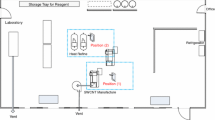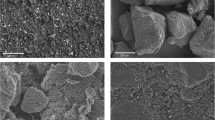Abstract
Carbon nanotubes (CNTs) are representative-engineered nanomaterials with unique properties. The safe production of CNTs urgently requires reliable tools to assess inhalation exposure. In this study, on-line aerosol instruments were employed to detect the release of multi-walled CNTs (MWCNTs) in workplace environments. The size responses of aerosol instruments consisting of both a scanning mobility particle sizer (SMPS) and an aerodynamic particle sizer (APS) were examined using five types of commercial MWCNTs. A MWCNT solution and powder were aerosolized using atomizing and shaking methods, respectively. Regardless of the phase and purity, the aerosolized MWCNTs showed consistent size distributions with both SMPS and APS. The SMPS and APS measurements revealed a dominant broad peak at approximately 200–400 nm and a distinct narrow peak at approximately 2 μm, respectively. Comparing with field application of the two aerosol instruments, the APS response could be a fingerprint of the MWCNTs in a real workplace environment. A modification of the atomizing method is recommended for the long-term inhalation toxicity studies.









Similar content being viewed by others
References
Aufderheide M, Mohr U (2004) A modified CULTEX® system for the direct exposure of bacteria to inhalable substances. Exp Toxicol Pathol 55(6):451–454
Bae GN, Lee SB, Park SM (2007) Vehicle-related fine particulate air pollution in Seoul, Korea. Asian J Atmos Environ 1(1):1–8
Baron PA, Deye GJ, Chen BT, Schwegler-Berry DE, Shvedova AA, Castranova V (2008) Aerosolization of single-walled carbon nanotubes for an inhalation study. Inhal Toxicol 20(8):751–760
Chen DR, Pui DYH (1997) Numerical modeling of the performance of differential mobility analyzers for nanometer aerosol measurements. J Aerosol Sci 28(6):985–1004
Chen DR, Pui DYH, Hummes D, Fissan H, Quant FR, Sem GJ (1998) Design and evaluation of a nanometer aerosol differential mobility analyzer (Nano-DMA). J Aerosol Sci 29(5/6):497–509
Davoren M, Herzog E, Casey A, Cottineau B, Chambers G, Byrne HJ, Lyng FM (2007) In vitro toxicity evaluation of single walled carbon nanotubes on human A549 lung cells. Toxicol In Vitro 21:438–448
Donaldson K, Aitken R, Tran L, Stone V, Duffin R, Forrest G, Alexander A (2006) Carbon nanotubes: a review of their properties in relation to pulmonary toxicology and workplace safety. Toxicol Sci 92:5–22
Giechaskiel B, Ntziachristos L, Samaras Z, Scheer V, Casati R, Vogt R (2005) Formation potential of vehicle exhaust nucleation mode particles on-road and in the laboratory. Atmos Environ 39:3191–3198
Han JH, Lee EJ, Lee JH, So KP, Lee YH, Bae GN, Lee S-B, Ji JH, Cho MH, Yu IJ (2008) Monitoring multiwalled carbon nanotube exposure in carbon nanotube research facility. Inhal Toxicol 20:741–749
Heitbrink WA, Evans DE, Ku BK, Maynard AD, Slavin TJ, Peters TM (2009) Relationships among particle number, surface area, and respirable mass concentrations in automotive engine manufacturing. J Occup Environ Hyg 6:19–31
Ji JH, Jung JH, Yu IJ, Kim SS (2007a) Long-term stability characteristics of metal nanoparticles generator using small ceramic heater for inhalation toxicity studies. Inhal Toxicol 19:745–751
Ji JH, Jung JH, Kim SS, Yoon JU, Park JD, Choi BS, Chung YH, Kwon IH, Jeong J, Han BS, Shin JH, Sung JH, Song KS, Yu IJ (2007b) Twenty-eight-day inhalation toxicity study of silver nanoparticles in Sprague-Dawley rats. Inhal Toxicol 19:857–871
Kim SH, Zachariah MR (2005) In-flight size classification of carbon nanotubes by gas phase electrophoresis. Nanotechnology 16:2149–2152
Kim SH, Zachariah MR (2006) In-flight kinetic measurements of the aerosol growth of carbon nanotubes by electrical mobility classification. J Phys Chem B 110:4555–4562
Kittelson DB (1998) Engines and nanoparticles: a review. J Aerosol Sci 29:575–588
Ku BK, Maynard AD (2005) Comparing aerosol surface-area measurements of monodisperse ultrafine silver agglomerates by mobility analysis, transmission electron microscopy and diffusion charging. J Aerosol Sci 36:1108–1124
Ku BK, Emery MS, Maynard AD, Stolzenburg MR, McMurry PH (2006) In situ structure characterization of airborne carbon nanofibres by a tandem mobility-mass analysis. Nanotechnology 17:3613–3621
Ku BK, Maynard AD, Baron PA, Deye GJ (2007) Observation and measurement of anomalous responses in a differential mobility analyzer caused by ultrafine fibrous carbon aerosols. J Electrostat 65:542–548
Lamorena RB, Jung SG, Bae GN, Lee W (2007) The formation of ultra-fine particles during ozone-initiated oxidations with terpenes emitted from natural paint. J Hazard Mater 141:245–251
Long CM, Suh HH, Koutrakis P (2000) Characterization of indoor particle sources using continuous mass and size monitors. J Air Waste Manag Assoc 50:1236–1250
Maynard AD, Baron PA, Foley M, Shvedova AA, Kisin ER, Castranova V (2004) Exposure to carbon nanotube material: aerosol release during the handling of unrefined single walled carbon nanotube material. J Toxicol Environ Health A 67:87–107
Maynard AD, Aitken RJ, Butz T, Colvin V, Donaldson K, Oberdorster G, Philbert MA, Ryan J, Seaton A, Stone V, Tinkle SS, Tran L, Walker NJ, Warheit DB (2006) Safe handling of nanotechnology. Nature 444:267–269
Maynard AD, Ku BK, Emery M, Stolzenburg M, McMurry PH (2007) Measuring particle size-dependent physiochemical structure in airborne single walled carbon nanotube agglomerates. J Nanopart Res 9:85–92
Mülhopt S, Paur H-R, Diabaté S, Krug HF (2007) In vitro testing of inhalable fly ash at the air–liquid interface. Advanced environmental monitoring. Springer, Netherlands, pp 402–414
Muller J, Huaux F, Lison D (2006) Respiratory toxicity of carbon nanotubes: how worried should we be? Carbon 44:1048–1056
Poland CA, Duffin R, Kinloch I, Maynard A, Wallace WAH, Seaton A, Stone V, Brown S, MacNee W, Donaldson K (2008) Carbon nanotubes introduced into the abdominal cavity of mice show asbestos-like pathogenicity in a pilot study. Nat Nanotechnol. doi:10.1038/nnano.2008.111
Rao S, Huang L, Setyawan W, Hong S (2003) Nanotube electronics: large-scale assembly of carbon nanotubes. Nature 425:36–37
Shin WG, Pui DYH, Fissan H, Neumann S, Trampe A (2007) Calibration and numerical simulation of nanoparticle surface area monitor (TSI Model 3550 NSAM). J Nanopart Res 9:61–69
Shvedova AA, Kisin E, Murray AR, Johnson VJ, Gorerlik O, Arepalli S, Hubbs F, Mercer RR, Keohavong P, Sussman N, Jin J, Yin J, Stone S, Chen BT, Deye G, Maynard AD, Castranova V, Baron PA, Kagan VE (2008) Inhalation versus aspiration of single-walled carbon nanotubes in C57BL/6 mice: inflammation, fibrosis, oxidative stress, and mutagenesis. Am J Physiol Lung Cell Mol Physiol 295(4):L552–L565
Sinnott SB, Andrews R (2001) Carbon nanotubes: synthesis, properties, and applications. Crit Rev Solid State Mater Sci 26:145–249
Watson JG, Chow JC, Park K, Lowenthal DH (2006) Nanoparticle and ultrafine particle events at the Fresno Supersite. J Air Waste Manag Assoc 56:417–430
Zhao Y, Xing G, Chai Z (2008) Nanotechnology: are carbon nanotubes safe? Nat Nanotechnol 3:191–192
Acknowledgments
This research was supported by Nano R&D program through the Korea Science and Engineering Foundation funded by the Ministry of Science & Technology, Korea (grant number M10609000021-06M0900-02111).
Author information
Authors and Affiliations
Corresponding author
Rights and permissions
About this article
Cite this article
Lee, SB., Lee, JH. & Bae, GN. Size response of an SMPS–APS system to commercial multi-walled carbon nanotubes. J Nanopart Res 12, 501–512 (2010). https://doi.org/10.1007/s11051-009-9745-4
Received:
Accepted:
Published:
Issue Date:
DOI: https://doi.org/10.1007/s11051-009-9745-4




